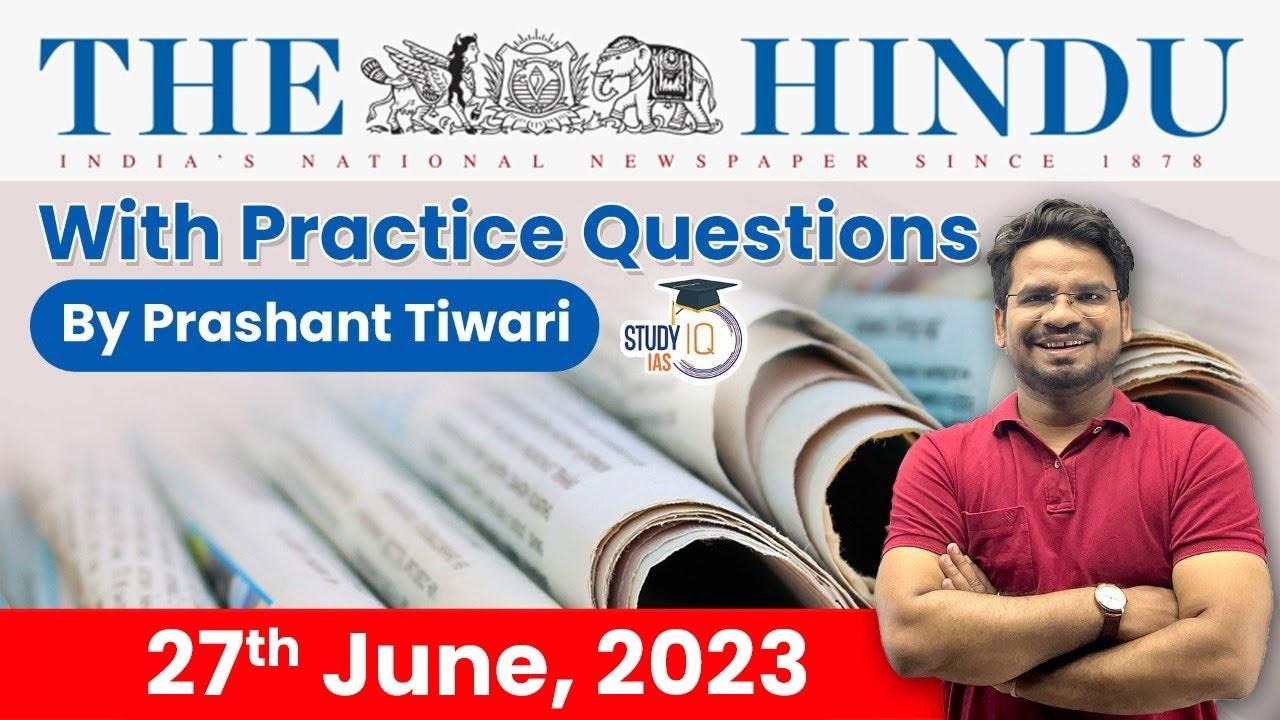The Hindu Newspaper Analysis for UPSC

The Hindu Newspaper Analysis 26 June 2023
- The Ministry of Electronics and IT has been actively organising consultations on the proposed “Digital India Bill” to build conceptual alignment on a new law that will replace India’s 23-year-old Information Technology (IT) Act. The goal is to upgrade the current legal regime to tackle emerging challenges such as user harm, competition and misinformation in the digital space.
- The current IT Act defines an “intermediary” to include any entity between a user and the Internet, and the IT Rules sub-classify intermediaries into three main categories: “Social Media Intermediaries” (SMIs), “Significant Social Media Intermediaries” (SSMIs) and the recently notified, “Online Gaming Intermediaries”.
- In doing so, it could help create a regulatory environment that helps achieve the government’s policy goal of creating a safer Internet ecosystem, while also allowing businesses to thrive.

- Chennai and Chandigarh witnessed the lowest-ever maximum temperatures recorded on a June day in the last seven decades, while Thiruvananthapuram recorded its hottest June day in the same period.


- As many as 149 pilgrims died in the first 65 days of the annual Char Dham Yatra season in Uttarakhand, show State Disaster Management data.
- Over 31.78 lakh people have visited the Badrinath, Kedarnath, Gangotri and Yamunotri temples since the pilgrimage season started on April 22.
- State Disaster Management officials said most pilgrims died from chronic ailments, unable to bear the harsh weather and tough terrain. Some of the pilgrims died in accidents on their way to the temples.
- “Most of the deaths were from heart attack,” an official from the Health Department said. The official added that most of the deceased were elderly who had failed to acclimatise to the weather.

- Days after the Maharashtra police rescued 11 labourers who were allegedly kept chained by a contractor in Osmanabad district, the National Human Rights Commission (NHRC) issued a notice to the State government, and sought a detailed report in the matter from the Chief Secretary and the Director-General of Police within four weeks.
- The NHRC had observed that the Provisions of the Bonded Labour System (Abolition) Act, 1976, had been grossly violated by the contractor. The incident clearly indicated the failure of the local administration to safeguard the labourers from such brutality committed upon them by the contractors, without any fear of the law.
- The workers had been kept chained and forced to work 12 hours a day, without any wages, digging a well for the accused. They had been given food just once a day and were forced to relieve themselves inside the well.
- About the Bonded Labour System (Abolition) Act 1976:
- The Act is being implemented by the concerned State Govts./UTs.
- The Act provides for an institutional mechanism at the district level in the form of Vigilance Committees.
- For the purpose of implementing the provisions of this Act, the State Governments/UTs may confer, on an Executive Magistrate, the powers of a Judicial Magistrate of the first class or second class for trial of offences under this Act.
- Government of India has introduced a revamped Central Sector Scheme for Rehabilitation of Bonded Labourers- 2016, under which financial assistance to the tune of Rs.1.00 (one) lakh, Rs.2.00 (two) lakhs & Rs. 3.00 (three) lakhs are provided to released bonded labourers based on their category and level of exploitation along with other non-cash assistance for their livelihood.
- Introduction:
- National Human Rights Commission of India (NHRC), is a statutory body established in 1993, under the provisions of The Protection of Human Rights Act, 1993
- It is responsible for the protection and promotion of “rights relating to life, liberty, equality and dignity of the individual guaranteed by the Constitution or embodied in the International Covenants”.
- Composition:
- The chairperson is a retired chief justice of India or a judge of the Supreme Court.
- They are appointed by the President on the recommendations of a six-member committee consisting of:
- Prime Minister (head)
- Speaker of the Lok Sabha
- Deputy Chairman of the Rajya Sabha
- Leaders of the Opposition in both the Houses of Parliament
- Union Home Minister.
- Term and removal:
- They hold office for a term of three years or until they attain the age of 70 years, whichever is earlier.
- The President can remove them from the office under specific circumstances.





















 WhatsApp
WhatsApp